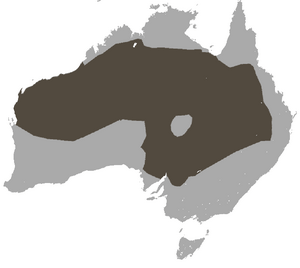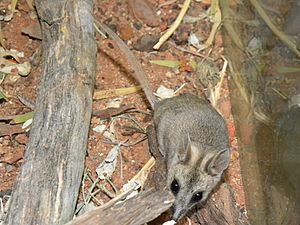Stripe-faced dunnart facts for kids
Quick facts for kids Stripe-faced dunnart |
|
|---|---|
 |
|
| Conservation status | |
| Scientific classification | |
| Genus: |
Sminthopsis
|
| Species: |
macroura
|
 |
|
| Stripe-faced dunnart range | |
The stripe-faced dunnart (Sminthopsis macroura) is a tiny Australian animal. It's a "marsupial mouse" that is active mostly at night. It belongs to a family of meat-eating marsupials called Dasyuridae. These dunnarts live across central and northern Australia. They prefer dry and partly dry places.
Even though they live in many areas, their numbers are going down in some parts of Australia. This is happening because their homes are being damaged. For example, in western New South Wales, their habitat is shrinking.
Because of this, the NSW Office of Environment and Heritage lists the species as 'vulnerable'. This means they are at risk of becoming endangered. However, other groups like the International Union for Conservation of Nature (IUCN) say the species is of 'least concern'.
Scientists have recently found something interesting. What we thought was one type of stripe-faced dunnart is actually three different species! They have slowly changed over millions of years. But because they look so similar, it's hard to tell them apart. So, they are often still treated as one species.
The three types of dunnarts are:
- Sminthopsis macroura macroura: Found in central, eastern, and western Australia.
- S.m. stalkeri: Lives in central northern Australia.
- S.m. froggatti: Found in the Kimberley region.
Contents
What Does It Look Like?
The stripe-faced dunnart is a small animal. It measures about 15.5 to 19.8 centimeters (6 to 7.8 inches) long from its nose to the tip of its tail. Its body, from nose to bottom, is about 7.5 to 9.8 cm (3 to 3.8 inches) long. Its tail is usually 8 to 10 cm (3.1 to 3.9 inches) long. Its ears are about 1.7 to 1.8 cm (0.6 to 0.7 inches) long.
These dunnarts weigh between 15 and 25 grams (0.5 to 0.9 ounces). That's about the weight of a few coins! Their fur is pale grey-brown on top. They have a clear dark stripe on their forehead. This stripe goes from their nose to between their ears. Their ears are a bit darker than other dunnart species. Their belly and feet are white. Their tail is often thick at the base and gets thinner towards the end. It also has hairs that go past the tip.
You can tell the stripe-faced dunnart apart from similar animals. For example, the fat-tailed dunnart (S. crassicaudara) does not have this dark stripe. The Julia Creek dunnart (S. douglasi) has a similar stripe. But the Julia Creek dunnart is much bigger. It weighs two to three times more. Its head and body are also longer, about 10 to 13.5 cm (3.9 to 5.3 inches).
In zoos, these dunnarts can live for almost 5 years.
Where They Live and Their Homes
The stripe-faced dunnart lives in a large area of central and northern Australia. This includes places like the Pilbara and the central Northern Territory. They also live in western and central Queensland, and south to north-east South Australia. You can find them in northern and western New South Wales too.
They live in many different types of habitats. Most of these are dry areas. They can be found in low shrublands with plants like saltbush (Atriplex spp.) and bluebush (Maireana spp.). They also live in spinifex grasslands on sandy soils. You might see them among sparse Acacia shrubs. They also live in tussock grasslands on clay, sandy, or stony soils. They can even be found on open salt lakes and low, rocky ridges with shrubs.
These dunnarts are most common in tussock grasslands and shrublands. Especially where there isn't too much overgrazing by farm animals or wild animals. They often prefer areas near natural drainage lines. These spots usually have more food and better places to hide. They find shelter under rocks and logs. They also hide in cracks in the soil and in thick tussock grass.
One study showed that these dunnarts can live and have babies in small areas of native plants. These areas were fenced to keep out large grazing animals. However, no adult dunnarts were found in the areas outside the fences where animals grazed. This might be because the fenced areas had more types of plants. More plants mean more insects for the dunnarts to eat. The thicker plants also offer more protection from predators. Also, without livestock, the soil is not as squashed. This allows for more soil cracks, which are great hiding and hunting spots for the dunnarts.
Life Cycle and Reproduction
Stripe-faced dunnarts have babies from July to February. Their pregnancy lasts only eleven days. This is the shortest pregnancy of any mammal! Females can have several litters in a season. Their cycle for having babies lasts about 23 to 25 days. Males can breed throughout the breeding season. They can even breed for up to three seasons.
A mother dunnart can have up to eight joeys (baby marsupials). This is the same as the number of nipples she has. The babies stay in her pouch for about 40 days. The pouch completely covers the tiny newborns. They stay attached to a nipple until they are well developed. If a mother only has one or two babies, she might not raise them. After leaving the pouch, the young stay in the nest. They continue to drink milk for another 30 days. Usually, a female will have two litters per season. But in captivity, they can sometimes have three.
Female dunnarts become adults and can have babies at about four months old. Males mature later, at about nine months old. Things like the temperature and how much food is available affect when they reproduce. Studies have shown that male stripe-faced dunnarts produce less sperm than other similar marsupials.
What They Eat
The stripe-faced dunnart mainly eats small animals without backbones, called invertebrates. They don't usually eat ants. Sometimes, they might also eat other small mammals or lizards. Scientists looked at the droppings of stripe-faced dunnarts. They found that their diet was completely made up of invertebrates. These included spiders (Arachnida), centipedes (Chilopoda), crustaceans (Crustacea), and insects (Insecta).
They are known to eat more termites (isopterans) than the fat-tailed dunnart. Stripe-faced dunnarts can eat up to 50% of their own body weight in food each day. Fat-tailed dunnarts need to eat up to 81% of their body weight. Yet, both species are about the same size.
How They Survive
The stripe-faced dunnart has special ways to live in the very dry Australian environment. This place has big changes in temperature and not much water or food. To handle the changing temperatures, they can keep their body temperature steady. But they also have a clear daily temperature cycle. They can also enter a deep sleep called torpor. And they avoid direct sunlight.
To stay cool in summer, they are active at night. During the day, they rest in burrows they dig. They also make nests from grass, leaves, and other things. They hide in hollow logs, under thick plants, or in tree holes. They also find shelter in cracks in the soil, under rocks, logs, and in other animal burrows.
To survive winter, they go into torpor every day. This usually happens at night. They wake up by midday and warm themselves in the sun. As winter nights get colder, their torpor lasts longer and is deeper. Females tend to stay in torpor longer than males. Torpor helps them save water and use up to 90% less energy. This means they need much less food. This is very helpful when food is hard to find in winter. Stripe-faced dunnarts might also go into daily torpor in summer. This happens if food is scarce or if temperatures are unstable.
Like the fat-tailed dunnart, the stripe-faced dunnart can store extra fat in its tail. They do this when there is plenty of food. They use this stored fat when food is hard to find, often in winter. These dunnarts can get all the water they need from the insects they eat.
Dangers They Face
The biggest dangers to the stripe-faced dunnart are too much grazing and trampling of plants. This is caused by wild animals and farm animals. Clearing land for farms, breaking up their habitats, and frequent large fires also harm their homes. Wild cats and red foxes (Vulpes vulpes) also hunt and kill dunnarts.
Removing fallen logs and branches is also a problem. Dunnarts use these for shelter from heat and predators. They also hunt for insects that live in or under the woody debris. These dunnarts are very sensitive to a pesticide called fenitrothion. This chemical is used by local farmers to control locusts. Even a small amount can make dunnarts tired and unable to move well. This makes it easier for predators to catch them.
Helping the Stripe-faced Dunnart
The NSW Office of Environment and Heritage has a program called 'Saving our Species'. Its goal is to protect as many threatened animals as possible. This includes the stripe-faced dunnart. Here are some things they are doing:
- They are trying out small fenced areas (10-20 hectares) on farms. These fences keep out large grazing animals. These areas will be safe places for the dunnarts. They will watch these sites to see if this plan works.
- They are working with landowners and fire managers. Their goal is to create a fire plan that protects patches of ground cover plants and dead wood.
- They are encouraging local landowners to protect areas of saltbush and other ground plants. They also ask them to reduce grazing and other disturbances.
- They are doing surveys in good dunnart habitats. This helps them find new groups of dunnarts. It also helps them learn how many dunnarts there are and where they live.
- They are raising awareness about the dangers of using fenitrothion. They are also telling local landowners about safer options.
- Groves, Colin (16 November 2005). Wilson, D. E., and Reeder, D. M. (eds). ed. Mammal Species of the World (3rd edition ed.). Johns Hopkins University Press. pp. 35. ISBN 0-801-88221-4. http://www.bucknell.edu/msw3.
Images for kids
See also
 In Spanish: Ratón marsupial de cara rayada para niños
In Spanish: Ratón marsupial de cara rayada para niños





